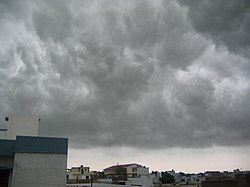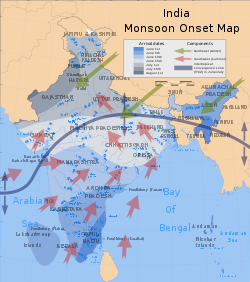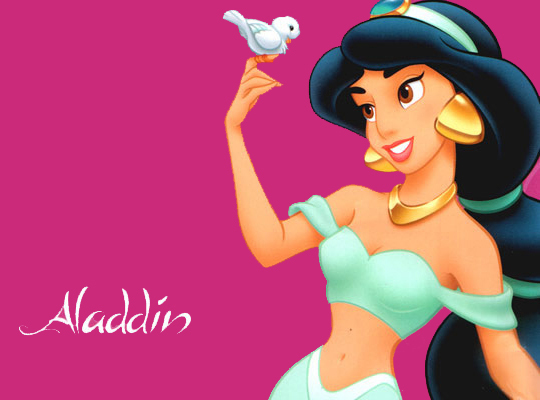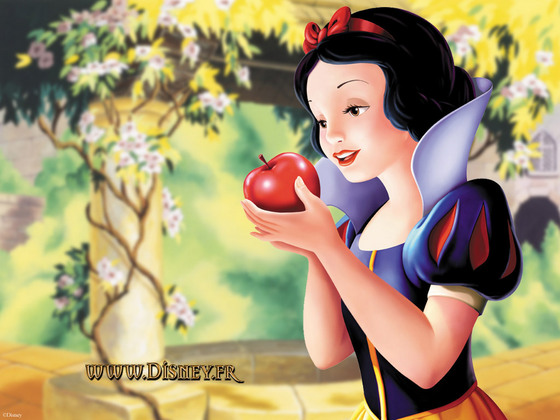Vampires are mythological or folkloric beings who subsist by feeding on the life essence (generally in the form of blood) of living creatures, regardless of whether they are undead or a living person. Although vampiric entities have been recorded in many cultures, and may go back to "prehistoric times", the term vampire was not popularized until the early 18th century, after an influx of vampire superstition into Western Europe from areas where vampire legends were frequent, such as the Balkans and Eastern Europe, although local variants were also known by different names, such as vrykolakas in Greece and strigoi in Romania. This increased level of vampire superstition in Europe led to mass hysteria and in some cases resulted in corpses actually being staked and people being accused of vampirism.
While even folkloric vampires of the Balkans and Eastern Europe had a wide range of appearance ranging from nearly human to bloated rotting corpses, it was the success of John Polidori's 1819 novella The Vampyre that established the archetype of charismatic and sophisticated vampire; it is arguably the most influential vampire work of the early 19th century, inspiring such works as Varney the Vampire and eventually Dracula.
However, it is Bram Stoker's 1897 novel Dracula that is remembered as the quintessential vampire novel and which provided the basis of modern vampire fiction. Dracula drew on earlier mythologies of werewolves and similar legendary demons and "was to voice the anxieties of an age", and the "fears of late Victorian patriarchy". The success of this book spawned a distinctive vampire genre, still popular in the 21st century, with books, films, video games, and television shows. The vampire is such a dominant figure in the horror genre that literary historian Susan Sellers places the current vampire myth in the "comparative safety of nightmare fantasy".
Etymology
The Oxford English Dictionary dates the first appearance of the word vampire in English from 1734, in a travelogue titled Travels of Three English Gentlemen published in the Harleian Miscellany in 1745. Vampires had already been discussed in German literature. After Austria gained control of northern Serbia and Oltenia with the Treaty of Passarowitz in 1718, officials noted the local practice of exhuming bodies and "killing vampires". These reports, prepared between 1725 and 1732, received widespread publicity.
The English term was derived (possibly via French vampyre) from the German Vampir, in turn derived in the early 18th century from the Serbian вампир/vampir, when Arnold Paole, a purported vampire in Serbia was described during the time Serbia was incorporated into the Austrian Empire.
The Serbian form has parallels in virtually all Slavic languages: Bulgarian and Macedonian вампир (vampir), Croatian upir /upirina, Czech and Slovak upír, Polish wąpierz, and (perhaps East Slavic-influenced) upiór, Ukrainian упир (upyr), Russian упырь (upyr'), Belarusian упыр (upyr), from Old East Slavic упирь (upir'). (Note that many of these languages have also borrowed forms such as "vampir/wampir" subsequently from the West; these are distinct from the original local words for the creature.) The exact etymology is unclear. Among the proposed proto-Slavic forms are *ǫpyrь and *ǫpirь. Another, less widespread theory, is that the Slavic languages have borrowed the word from a Turkic term for "witch" (e.g., Tatar ubyr).
The first recorded use of the Old Russian form Упирь (Upir') is commonly believed to be in a document dated 6555 (1047 AD). It is a colophon in a manuscript of the Book of Psalms written by a priest who transcribed the book from Glagolitic into Cyrillic for the Novgorodian Prince Volodymyr Yaroslavovych. The priest writes that his name is "Upir' Likhyi " (Оупирь Лихыи), which means something like "Wicked Vampire" or "Foul Vampire". This apparently strange name has been cited as an example both of surviving paganism and of the use of nicknames as personal names.
Another early use of the Old Russian word is in the anti-pagan treatise "Word of Saint Grigoriy", dated variously to the 11th–13th centuries, where pagan worship of upyri is reported.
Folk beliefs
The notion of vampirism has existed for millennia; cultures such as the Mesopotamians, Hebrews, Ancient Greeks, and Romans had tales of demons and spirits which are considered precursors to modern vampires. However, despite the occurrence of vampire-like creatures in these ancient civilizations, the folklore for the entity we know today as the vampire originates almost exclusively from early 18th-century southeastern Europe, when verbal traditions of many ethnic groups of the region were recorded and published. In most cases, vampires are revenants of evil beings, suicide victims, or witches, but they can also be created by a malevolent spirit possessing a corpse or by being bitten by a vampire. Belief in such legends became so pervasive that in some areas it caused mass hysteria and even public executions of people believed to be vampires.
Description and common attributes

Vampyren, "The Vampire", by Edvard Munch
It is difficult to make a single, definitive description of the folkloric vampire, though there are several elements common to many European legends. Vampires were usually reported as bloated in appearance, and ruddy, purplish, or dark in color; these characteristics were often attributed to the recent drinking of blood. Indeed, blood was often seen seeping from the mouth and nose when one was seen in its shroud or coffin and its left eye was often open. It would be clad in the linen shroud it was buried in, and its teeth, hair, and nails may have grown somewhat, though in general fangs were not a feature.
Creating vampires
The causes of vampiric generation were many and varied in original folklore. In Slavic and Chinese traditions, any corpse that was jumped over by an animal, particularly a dog or a cat, was feared to become one of the undead. A body with a wound that had not been treated with boiling water was also at risk. In Russian folklore, vampires were said to have once been witches or people who had rebelled against the Russian Orthodox Church while they were alive.
Cultural practices often arose that were intended to prevent a recently deceased loved one from turning into an undead revenant. Burying a corpse upside-down was widespread, as was placing earthly objects, such as scythes or sickles, near the grave to satisfy any demons entering the body or to appease the dead so that it would not wish to arise from its coffin. This method resembles the Ancient Greek practice of placing an obolus in the corpse's mouth to pay the toll to cross the River Styx in the underworld; it has been argued that instead, the coin was intended to ward off any evil spirits from entering the body, and this may have influenced later vampire folklore. This tradition persisted in modern Greek folklore about the vrykolakas, in which a wax cross and piece of pottery with the inscription "Jesus Christ conquers" were placed on the corpse to prevent the body from becoming a vampire. Other methods commonly practised in Europe included severing the tendons at the knees or placing poppy seeds, millet, or sand on the ground at the grave site of a presumed vampire; this was intended to keep the vampire occupied all night by counting the fallen grains, indicating an association of vampires with arithmomania. Similar Chinese narratives state that if a vampire-like being came across a sack of rice, it would have to count every grain; this is a theme encountered in myths from the Indian subcontinent, as well as in South American tales of witches and other sorts of evil or mischievous spirits or beings. In Albanian folklore, the dhampir is the son of the karkanxholl or the lugat. If the karkanxholl sleeps with his wife, and she is impregnated with a child, the offspring is called dhampir and has the unique ability to discern the karkanxholl; from this derives the expression the dhampir knows the lugat. The lugat cannot be seen, he can only be killed by the dhampir, who himself is usually the son of a lugat. In different regions, animals can be revenants as lugats; also, living people during their sleep. Dhampiraj is also an Albanian surname.
Identifying vampires
Many elaborate rituals were used to identify a vampire. One method of finding a vampire's grave involved leading a virgin boy through a graveyard or church grounds on a virgin stallion—the horse would supposedly balk at the grave in question. Generally a black horse was required, though in Albania it should be white. Holes appearing in the earth over a grave were taken as a sign of vampirism.
Corpses thought to be vampires were generally described as having a healthier appearance than expected, plump and showing little or no signs of decomposition. In some cases, when suspected graves were opened, villagers even described the corpse as having fresh blood from a victim all over its face. Evidence that a vampire was active in a given locality included death of cattle, sheep, relatives or neighbours. Folkloric vampires could also make their presence felt by engaging in minor poltergeist-like activity, such as hurling stones on roofs or moving household objects, and pressing on people in their sleep.
Protection
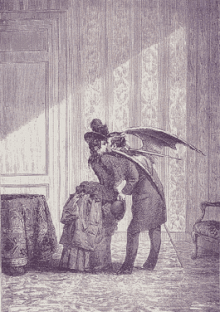
An image from Max Ernst's
Une Semaine de Bonté Apotropaics
Apotropaics, items able to ward off revenants, are common in vampire folklore. Garlic is a common example, a branch of wild rose and hawthorn plant are said to harm vampires, and in Europe, sprinkling mustard seeds on the roof of a house was said to keep them away.Other apotropaics include sacred items, for example a crucifix, rosary, or holy water. Vampires are said to be unable to walk on consecrated ground, such as those of churches or temples, or cross running water. Although not traditionally regarded as an apotropaic, mirrors have been used to ward off vampires when placed, facing outwards, on a door (in some cultures, vampires do not have a reflection and sometimes do not cast a shadow, perhaps as a manifestation of the vampire's lack of a soul). This attribute, although not universal (the Greek vrykolakas/tympanios was capable of both reflection and shadow), was used by Bram Stoker in Dracula and has remained popular with subsequent authors and filmmakers. Some traditions also hold that a vampire cannot enter a house unless invited by the owner, although after the first invitation they can come and go as they please. Though folkloric vampires were believed to be more active at night, they were not generally considered vulnerable to sunlight.
Methods of destruction
Methods of destroying suspected vampires varied, with staking the most commonly cited method, particularly in southern Slavic cultures. Ash was the preferred wood in Russia and the Baltic states, or hawthorn in Serbia, with a record of oak in Silesia. Potential vampires were most often staked through the heart, though the mouth was targeted in Russia and northern Germany and the stomach in north-eastern Serbia. Piercing the skin of the chest was a way of "deflating" the bloated vampire; this is similar to the act of burying sharp objects, such as sickles, in with the corpse, so that they may penetrate the skin if the body bloats sufficiently while transforming into a revenant. Decapitation was the preferred method in German and western Slavic areas, with the head buried between the feet, behind the buttocks or away from the body. This act was seen as a way of hastening the departure of the soul, which in some cultures, was said to linger in the corpse. The vampire's head, body, or clothes could also be spiked and pinned to the earth to prevent rising. Gypsies drove steel or iron needles into a corpse's heart and placed bits of steel in the mouth, over the eyes, ears and between the fingers at the time of burial. They also placed hawthorn in the corpse's sock or drove a hawthorn stake through the legs. In a 16th-century burial near Venice, a brick forced into the mouth of a female corpse has been interpreted as a vampire-slaying ritual by the archaeologists who discovered it in 2006. Further measures included pouring boiling water over the grave or complete incineration of the body. In the Balkans, a vampire could also be killed by being shot or drowned, by repeating the funeral service, by sprinkling holy water on the body, or by exorcism. In Romania, garlic could be placed in the mouth, and as recently as the 19th century, the precaution of shooting a bullet through the coffin was taken. For resistant cases, the body was dismembered and the pieces burned, mixed with water, and administered to family members as a cure. In Saxon regions of Germany, a lemon was placed in the mouth of suspected vampires.
Ancient beliefs
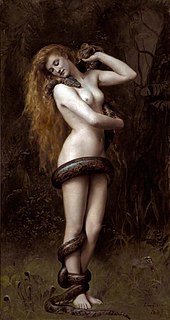
Lilith (1892), by John Collier
Ancient Greek and Roman mythology described the Empusae, the Lamia, and the striges. Over time the first two terms became general words to describe witches and demons respectively. Empusa was the daughter of the goddess Hecate and was described as a demonic, bronze-footed creature. She feasted on blood by transforming into a young woman and seduced men as they slept before drinking their blood. The Lamia preyed on young children in their beds at night, sucking their blood, as did the gelloudes or Gello. Like the Lamia, the striges feasted on children, but also preyed on young men. They were described as having the bodies of crows or birds in general, and were later incorporated into Roman mythology as strix, a kind of nocturnal bird that fed on human flesh and blood.
Medieval and later European folklore
Many of the myths surrounding vampires originated during the medieval period. The 12th century English historians and chroniclers Walter Map and William of Newburgh recorded accounts of revenants, though records in English legends of vampiric beings after this date are scant. The Old Norse draugr is another medieval example of an undead creature with similarities to vampires.
Vampires proper originate in folklore widely reported from Eastern Europe in the late 17th and 18th centuries. These tales formed the basis of the vampire legend that later entered Germany and England, where they were subsequently embellished and popularised. One of the earliest recordings of vampire activity came from the region of Istria in modern Croatia, in 1672.Local reports cited the local vampire Giure Grando of the village Khring near Tinjan as the cause of panic among the villagers. A former peasant, Guire died in 1656, however, local villagers claimed he returned from the dead and began drinking blood from the people and sexually harassing his widow. The village leader ordered a stake to be driven through his heart, but when the method failed to kill him, he was subsequently beheaded with better results.
During the 18th century, there was a frenzy of vampire sightings in Eastern Europe, with frequent stakings and grave diggings to identify and kill the potential revenants; even government officials engaged in the hunting and staking of vampires.Despite being called the Age of Enlightenment, during which most folkloric legends were quelled, the belief in vampires increased dramatically, resulting in a mass hysteria throughout most of Europe. The panic began with an outbreak of alleged vampire attacks in East Prussia in 1721 and in the Habsburg Monarchy from 1725 to 1734, which spread to other localities. Two famous vampire cases, the first to be officially recorded, involved the corpses of Peter Plogojowitz and Arnold Paole from Serbia. Plogojowitz was reported to have died at the age of 62, but allegedly returned after his death asking his son for food. When the son refused, he was found dead the following day. Plogojowitz supposedly returned and attacked some neighbours who died from loss of blood.In the second case, Paole, an ex-soldier turned farmer who allegedly was attacked by a vampire years before, died while haying. After his death, people began to die in the surrounding area and it was widely believed that Paole had returned to prey on the neighbours. Another famous Serbian legend involving vampires concentrates around a certain Sava Savanović living in a watermill and killing and drinking blood from millers. The character was later used in a story written by Serbian writer Milovan Glišić and in the Serbian 1973 horror film Leptirica inspired by the story.
The two incidents were well-documented: government officials examined the bodies, wrote case reports, and published books throughout Europe.[78] The hysteria, commonly referred to as the "18th-Century Vampire Controversy", raged for a generation. The problem was exacerbated by rural epidemics of so-claimed vampire attacks, undoubtedly caused by the higher amount of superstition that was present in village communities, with locals digging up bodies and in some cases, staking them. Although many scholars reported during this period that vampires did not exist, and attributed reports to premature burial or rabies, superstitious belief increased. Dom Augustine Calmet, a well-respected French theologian and scholar, put together a comprehensive treatise in 1746, which was ambiguous concerning the existence of vampires. Calmet amassed reports of vampire incidents; numerous readers, including both a critical Voltaire and supportive demonologists, interpreted the treatise as claiming that vampires existed.[79] In his Philosophical Dictionary, Voltaire wrote:
These vampires were corpses, who went out of their graves at night to suck the blood of the living, either at their throats or stomachs, after which they returned to their cemeteries. The persons so sucked waned, grew pale, and fell into consumption; while the sucking corpses grew fat, got rosy, and enjoyed an excellent appetite. It was in Poland, Hungary, Silesia, Moravia, Austria, and Lorraine, that the dead made this good cheer.
The controversy only ceased when Empress Maria Theresa of Austria sent her personal physician, Gerard van Swieten, to investigate the claims of vampiric entities. He concluded that vampires did not exist and the Empress passed laws prohibiting the opening of graves and desecration of bodies, sounding the end of the vampire epidemics. Despite this condemnation, the vampire lived on in artistic works and in local superstition.
Non-European beliefs
Africa
Various regions of Africa have folkloric tales of beings with vampiric abilities: in West Africa the Ashanti people tell of the iron-toothed and tree-dwelling asanbosam, and the Ewe people of the adze, which can take the form of a firefly and hunts children. The eastern Cape region has the impundulu, which can take the form of a large taloned bird and can summon thunder and lightning, and the Betsileo people of Madagascar tell of the ramanga, an outlaw or living vampire who drinks the blood and eats the nail clippings of nobles.
The Americas
The Loogaroo is an example of how a vampire belief can result from a combination of beliefs, here a mixture of French and African Vodu or voodoo. The term Loogaroo possibly comes from the French loup-garou (meaning "werewolf") and is common in the culture of Mauritius. However, the stories of the Loogaroo are widespread through the Caribbean Islands and Louisiana in the United States. Similar female monsters are the Soucouyant of Trinidad, and the Tunda and Patasola of Colombian folklore, while the Mapuche of southern Chile have the bloodsucking snake known as the Peuchen. Aloe vera hung backwards behind or near a door was thought to ward off vampiric beings in South American superstition. Aztec mythology described tales of the Cihuateteo, skeletal-faced spirits of those who died in childbirth who stole children and entered into sexual liaisons with the living, driving them mad.
During the late 18th and 19th centuries the belief in vampires was widespread in parts of New England, particularly in Rhode Island and Eastern Connecticut. There are many documented cases of families disinterring loved ones and removing their hearts in the belief that the deceased was a vampire who was responsible for sickness and death in the family, although the term "vampire" was never actually used to describe the deceased. The deadly disease tuberculosis, or "consumption" as it was known at the time, was believed to be caused by nightly visitations on the part of a dead family member who had died of consumption themselves. The most famous, and most recently recorded, case of suspected vampirism is that of nineteen-year-old Mercy Brown, who died in Exeter, Rhode Island in 1892. Her father, assisted by the family physician, removed her from her tomb two months after her death, cut out her heart and burned it to ashes.
Asia
Rooted in older folklore, the modern belief in vampires spread throughout Asia with tales of ghoulish entities from the mainland, to vampiric beings from the islands of Southeast Asia.
South Asia also developed other vampiric legends. The Bhūta or Prét is the soul of a man who died an untimely death. It wanders around animating dead bodies at night, attacking the living much like a ghoul. In northern India, there is the BrahmarākŞhasa, a vampire-like creature with a head encircled by intestines and a skull from which it drank blood. The figure of the Vetāla who appears in South Asian legend and story may sometimes be rendered as "Vampire" (see the section on "Ancient Beliefs" above).
Although vampires have appeared in Japanese cinema since the late 1950s, the folklore behind it is western in origin. However, the Nukekubi is a being whose head and neck detach from its body to fly about seeking human prey at night.
Legends of female vampire-like beings who can detach parts of their upper body also occur in the Philippines, Malaysia and Indonesia. There are two main vampire-like creatures in the Philippines: the Tagalog mandurugo ("blood-sucker") and the Visayan manananggal ("self-segmenter"). The mandurugo is a variety of the aswang that takes the form of an attractive girl by day, and develops wings and a long, hollow, thread-like tongue by night. The tongue is used to suck up blood from a sleeping victim. The manananggal is described as being an older, beautiful woman capable of severing its upper torso in order to fly into the night with huge bat-like wings and prey on unsuspecting, sleeping pregnant women in their homes. They use an elongated proboscis-like tongue to suck fetuses from these pregnant women. They also prefer to eat entrails (specifically the heart and the liver) and the phlegm of sick people.
The Malaysian Penanggalan may be either a beautiful old or young woman who obtained her beauty through the active use of black magic or other unnatural means, and is most commonly described in local folklore to be dark or demonic in nature. She is able to detach her fanged head which flies around in the night looking for blood, typically from pregnant women. Malaysians would hang jeruju (thistles) around the doors and windows of houses, hoping the Penanggalan would not enter for fear of catching its intestines on the thorns. The Leyak is a similar being from Balinese folklore. A Kuntilanak or Matianak in Indonesia, or Pontianak or Langsuir in Malaysia, is a woman who died during childbirth and became undead, seeking revenge and terrorizing villages. She appeared as an attractive woman with long black hair that covered a hole in the back of her neck, with which she sucked the blood of children. Filling the hole with her hair would drive her off. Corpses had their mouths filled with glass beads, eggs under each armpit, and needles in their palms to prevent them from becoming langsuir.
Jiang Shi (simplified Chinese: 僵尸; traditional Chinese: 僵屍 or 殭屍; pinyin: jiāngshī; literally "stiff corpse"), sometimes called "Chinese vampires" by Westerners, are reanimated corpses that hop around, killing living creatures to absorb life essence (qì) from their victims. They are said to be created when a person's soul (魄 pò) fails to leave the deceased's body. However, some have disputed the comparison of jiang shi with vampires, as jiang shi are usually mindless creatures with no independent thought. One unusual feature of this monster is its greenish-white furry skin, perhaps derived from fungus or mold growing on coes.
Modern beliefs
In modern fiction, the vampire tends to be depicted as a suave, charismatic villain. Despite the general disbelief in vampiric entities, occasional sightings of vampires are reported. Indeed, vampire hunting societies still exist, although they are largely formed for social reasons.Allegations of vampire attacks swept through the African country of Malawi during late 2002 and early 2003, with mobs stoning one individual to death and attacking at least four others, including Governor Eric Chiwaya, based on the belief that the government was colluding with vampires.
In early 1970 local press spread rumors that a vampire haunted Highgate Cemetery in London. Amateur vampire hunters flocked in large numbers to the cemetery. Several books have been written about the case, notably by Sean Manchester, a local man who was among the first to suggest the existence of the "Highgate Vampire" and who later claimed to have exorcised and destroyed a whole nest of vampires in the area. In January 2005, rumours circulated that an attacker had bitten a number of people in Birmingham, England, fuelling concerns about a vampire roaming the streets. However, local police stated that no such crime had been reported and that the case appears to be an urban legend.
In 2006, a physics professor at the University of Central Florida wrote a paper arguing that it is mathematically impossible for vampires to exist, based on geometric progression. According to the paper, if the first vampire had appeared on January 1, 1600, and it fed once a month (which is less often than what is depicted in films and folklore), and every victim turned into a vampire, then within two and a half years the entire human population of the time would have become vampires. The paper made no attempt to address the credibility of the assumption that every vampire victim would turn into a vampire.
In one of the more notable cases of vampiric entities in the modern age, the chupacabra ("goat-sucker") of Puerto Rico and Mexico is said to be a creature that feeds upon the flesh or drinks the blood of domesticated animals, leading some to consider it a kind of vampire. The "chupacabra hysteria" was frequently associated with deep economic and political crises, particularly during the mid-1990s.
In Europe, where much of the vampire folklore originates, the vampire is considered a fictitious being, although many communities have embraced the revenant for economic purposes. In some cases, especially in small localities, vampire superstition is still rampant and sightings or claims of vampire attacks occur frequently. In Romania during February 2004, several relatives of Toma Petre feared that he had become a vampire. They dug up his corpse, tore out his heart, burned it, and mixed the ashes with water in order to drink it.
Vampirism and the Vampire lifestyle also represent a relevant part of modern day's occultist movements. The mythos of the vampire, his magickal qualities, allure, and predatory archetype express a strong symbolism that can be used in ritual, energy work, and magick, and can even be adopted as a spiritual system. The vampire has been part of the occult society in Europe for centuries and has spread into the American sub-culture as well for more than a decade, being strongly influenced by and mixed with the neo gothic aesthetics.
Collective noun
'Coven' has been used as a collective noun for vampires, possibly based on the Wiccan usage. An alternative collective noun is a 'house' of vampires. David Malki, author of Wondermark, suggests in Wondermark #566 the use of the collective noun 'basement', as in "A basement of vampires."
Origins of vampire beliefs

Le Vampire, lithograph by R. de Moraine in Féval (1851–1852).
Commentators have offered many theories for the origins of vampire beliefs, trying to explain the superstition - and sometimes mass hysteria - caused by vampires. Everything ranging from premature burial to the early ignorance of the body's decomposition cycle after death has been cited as the cause for the belief in vampires.
Slavic spiritualism
Although many cultures possess revenant superstitions comparable to the Eastern European vampire, the Slavic vampire is the revenant superstition that pervades popular culture's concept of vampire. The roots of vampire belief in Slavic culture are based to a large extent in the spiritual beliefs and practices of pre-Christianized Slavic peoples and their understanding of life after death. Despite a lack of pre-Christian Slavic writings describing the details of the "Old Religion", many pagan spiritual beliefs and rituals have been sustained by Slavic peoples even after their lands were Christianized. Examples of such beliefs and practices include ancestor worship, household spirits, and beliefs about the soul after death. The origins of vampire beliefs in Slavic regions can be traced to the complex structure of Slavic spiritualism.
Demons and spirits served important functions in pre-industrial Slavic societies and were considered to be very interactive in the lives and domains of humans. Some spirits were benevolent and could be helpful in human tasks, others were harmful and often destructive. Examples of such spirits are Domovoi, Rusalka, Vila, Kikimora, Poludnitsa, and Vodyanoy. These spirits were also considered to be derived from ancestors or certain deceased humans. Such spirits could appear at will in various forms including that of different animals or human form. Some of these spirits could also participate in malevolent activity to harm humans, such as drowning humans, obstructing the harvest, or sucking the blood of livestock and sometimes humans. Hence, the Slavs were obliged to appease these spirits to prevent the spirits from their potential for erratic and destructive behavior.
Common Slavic belief indicates a stark distinction between soul and body. The soul is not considered to be perishable. The Slavs believed that upon death the soul would go out of the body and wander about its neighborhood and workplace for 40 days before moving on to an eternal afterlife. Because of this, it was considered necessary to leave a window or door open in the house for the soul to pass through at its leisure. During this time the soul was believed to have the capability of re-entering the corpse of the deceased. Much like the spirits mentioned earlier, the passing soul could either bless or wreak havoc on its family and neighbors during its 40 days of passing. Upon an individual's death, much stress was placed on proper burial rites to ensure the soul's purity and peace as it separated from the body. The death of an unbaptized child, a violent or an untimely death, or the death of a grievous sinner (such as a sorcerer or murderer) were all grounds for a soul to become unclean after death. A soul could also be made unclean if its body were not given a proper burial. Alternatively, a body not given a proper burial could be susceptible to possession by other unclean souls and spirits. Slavs feared unclean souls because of their potential for taking vengeance.
From these deeply implicated beliefs pertaining to death and the soul derives the invention of the Slavic concept of vampir. A vampire is the manifestation of an unclean spirit possessing a decomposing body. This undead creature is considered to be vengeful and jealous towards the living and needing the blood of the living to sustain its body's existence. Although this concept of vampire exists in slightly deviating forms throughout Slavic countries and some of their non-Slavic neighbors, it is possible to trace the development of vampire belief to Slavic spiritualism pre-existing Christianity in Slavic regions.
Pathology
Decomposition
Paul Barber in his book Vampires, Burial and Death has described that belief in vampires resulted from people of pre-industrial societies attempting to explain the natural, but to them inexplicable, process of death and decomposition.
People sometimes suspected vampirism when a cadaver did not look as they thought a normal corpse should when disinterred. However, rates of decomposition vary depending on temperature and soil composition, and many of the signs are little known. This has led vampire hunters to mistakenly conclude that a dead body had not decomposed at all, or, ironically, to interpret signs of decomposition as signs of continued life. Corpses swell as gases from decomposition accumulate in the torso and the increased pressure forces blood to ooze from the nose and mouth. This causes the body to look "plump," "well-fed," and "ruddy"—changes that are all the more striking if the person was pale or thin in life. In the Arnold Paole case, an old woman's exhumed corpse was judged by her neighbours to look more plump and healthy than she had ever looked in life. The exuding blood gave the impression that the corpse had recently been engaging in vampiric activity. Darkening of the skin is also caused by decomposition. The staking of a swollen, decomposing body could cause the body to bleed and force the accumulated gases to escape the body. This could produce a groan-like sound when the gases moved past the vocal cords, or a sound reminiscent of flatulence when they passed through the anus. The official reporting on the Peter Plogojowitz case speaks of "other wild signs which I pass by out of high respect".
After death, the skin and gums lose fluids and contract, exposing the roots of the hair, nails, and teeth, even teeth that were concealed in the jaw. This can produce the illusion that the hair, nails, and teeth have grown. At a certain stage, the nails fall off and the skin peels away, as reported in the Plogojowitz case—the dermis and nail beds emerging underneath were interpreted as "new skin" and "new nails".
Premature burial
It has also been hypothesized that vampire legends were influenced by individuals being buried alive because of shortcomings in the medical knowledge of the time. In some cases in which people reported sounds emanating from a specific coffin, it was later dug up and fingernail marks were discovered on the inside from the victim trying to escape. In other cases the person would hit their heads, noses or faces and it would appear that they had been "feeding." A problem with this theory is the question of how people presumably buried alive managed to stay alive for any extended period without food, water or fresh air. An alternate explanation for noise is the bubbling of escaping gases from natural decomposition of bodies. Another likely cause of disordered tombs is grave robbing.
Contagion
Folkloric vampirism has been associated with clusters of deaths from unidentifiable or mysterious illnesses, usually within the same family or the same small community. The epidemic allusion is obvious in the classical cases of Peter Plogojowitz and Arnold Paole, and even more so in the case of Mercy Brown and in the vampire beliefs of New England generally, where a specific disease, tuberculosis, was associated with outbreaks of vampirism. As with the pneumonic form of bubonic plague, it was associated with breakdown of lung tissue which would cause blood to appear at the lips.
Porphyria
In 1985 biochemist David Dolphin proposed a link between the rare blood disorder porphyria and vampire folklore. Noting that the condition is treated by intravenous haem, he suggested that the consumption of large amounts of blood may result in haem being transported somehow across the stomach wall and into the bloodstream. Thus vampires were merely sufferers of porphyria seeking to replace haem and alleviate their symptoms. The theory has been rebuffed medically as suggestions that porphyria sufferers crave the haem in human blood, or that the consumption of blood might ease the symptoms of porphyria, are based on a misunderstanding of the disease. Furthermore, Dolphin was noted to have confused fictional (bloodsucking) vampires with those of folklore, many of whom were not noted to drink blood. Similarly, a parallel is made between sensitivity to sunlight by sufferers, yet this was associated with fictional and not folkloric vampires. In any case, Dolphin did not go on to publish his work more widely. Despite being dismissed by experts, the link gained media attention and entered popular modern folklore.
Rabies
Rabies has been linked with vampire folklore. Dr Juan Gómez-Alonso, a neurologist at Xeral Hospital in Vigo, Spain, examined this possibility in a report in Neurology. The susceptibility to garlic and light could be due to hypersensitivity, which is a symptom of rabies. The disease can also affect portions of the brain that could lead to disturbance of normal sleep patterns (thus becoming nocturnal) and hypersexuality. Legend once said a man was not rabid if he could look at his own reflection (an allusion to the legend that vampires have no reflection). Wolves and bats, which are often associated with vampires, can be carriers of rabies. The disease can also lead to a drive to bite others and to a bloody frothing at the mouth.
Psychodynamic understanding
In his 1931 treatise On the Nightmare, Welsh psychoanalyst Ernest Jones noted that vampires are symbolic of several unconscious drives and defence mechanisms. Emotions such as love, guilt, and hate fuel the idea of the return of the dead to the grave. Desiring a reunion with loved ones, mourners may project the idea that the recently dead must in return yearn the same. From this arises the belief that folkloric vampires and revenants visit relatives, particularly their spouses, first. In cases where there was unconscious guilt associated with the relationship, however, the wish for reunion may be subverted by anxiety. This may lead to repression, which Sigmund Freud had linked with the development of morbid dread. Jones surmised in this case the original wish of a (sexual) reunion may be drastically changed: desire is replaced by fear; love is replaced by sadism, and the object or loved one is replaced by an unknown entity. The sexual aspect may or may not be present. Some modern critics have proposed a simpler theory: People identify with immortal vampires because, by so doing, they overcome, or at least temporarily escape from, their fear of dying.
The innate sexuality of bloodsucking can be seen in its intrinsic connection with cannibalism and folkloric one with incubus-like behaviour. Many legends report various beings draining other fluids from victims, an unconscious association with semen being obvious. Finally Jones notes that when more normal aspects of sexuality are repressed, regressed forms may be expressed, in particular sadism; he felt that oral sadism is integral in vampiric behaviour.
Political interpretation
The reinvention of the vampire myth in the modern era is not without political overtones.[134] The aristocratic Count Dracula, alone in his castle apart from a few demented retainers, appearing only at night to feed on his peasantry, is symbolic of the parasitic Ancien regime. Werner Herzog, in his Nosferatu the Vampyre, gives this political interpretation an extra ironic twist when protagonist Jonathon Harker, a middle-class solicitor, becomes the next vampire; in this way the capitalist bourgeois becomes the next parasitic class.
Psychopathology
A number of murderers have performed seemingly vampiric rituals upon their victims. Serial killers Peter Kürten and Richard Trenton Chase were both called "vampires" in the tabloids after they were discovered drinking the blood of the people they murdered. Similarly, in 1932, an unsolved murder case in Stockholm, Sweden was nicknamed the "Vampire murder", because of the circumstances of the victim’s death. The late 16th-century Hungarian countess and mass murderer Elizabeth Báthory became particularly infamous in later centuries' works, which depicted her bathing in her victims' blood in order to retain beauty or youth.[137]
Modern vampire subcultures
Vampire lifestyle is a term for a contemporary subculture of people, largely within the Goth subculture, who consume the blood of others as a pastime; drawing from the rich recent history of popular culture related to cult symbolism, horror films, the fiction of Anne Rice, and the styles of Victorian England. Active vampirism within the vampire subculture includes both blood-related vampirism, commonly referred to as sanguine vampirism, and psychic vampirism, or supposed feeding from pranic energy.
Vampire bats
Although many cultures have stories about them, vampire bats have only recently become an integral part of the traditional vampire lore. Indeed, vampire bats were only integrated into vampire folklore when they were discovered on the South American mainland in the 16th century. Although there are no vampire bats in Europe, bats and owls have long been associated with the supernatural and omens, although mainly because of their nocturnal habits, and in modern English heraldic tradition, a bat means "Awareness of the powers of darkness and chaos"
The three species of actual vampire bats are all endemic to Latin America, and there is no evidence to suggest that they had any Old World relatives within human memory. It is therefore impossible that the folkloric vampire represents a distorted presentation or memory of the vampire bat. The bats were named after the folkloric vampire rather than vice versa; the Oxford English Dictionary records their folkloric use in English from 1734 and the zoological not until 1774. Although the vampire bat's bite is usually not harmful to a person, the bat has been known to actively feed on humans and large prey such as cattle and often leave the trademark, two-prong bite mark on its victim's skin.
In modern fiction
The vampire is now a fixture in popular fiction. Such fiction began with 18th century poetry and continued with 19th century short stories, the first and most influential of which was John Polidori's The Vampyre (1819), featuring the vampire Lord Ruthven. Lord Ruthven's exploits were further explored in a series of vampire plays in which he was the anti-hero. The vampire theme continued in penny dreadful serial publications such as Varney the Vampire (1847) and culminated in the pre-eminent vampire novel of all time: Dracula by Bram Stoker, published in 1897. Over time, some attributes now regarded as integral became incorporated into the vampire's profile: fangs and vulnerability to sunlight appeared over the course of the 19th century, with Varney the Vampire and Count Dracula both bearing protruding teeth, and Murnau's Nosferatu (1922) fearing daylight.[146] The cloak appeared in stage productions of the 1920s, with a high collar introduced by playwright Hamilton Deane to help Dracula 'vanish' on stage. Lord Ruthven and Varney were able to be healed by moonlight, although no account of this is known in traditional folklore. Implied though not often explicitly documented in folklore, immortality is one attribute which features heavily in vampire film and literature. Much is made of the price of eternal life, namely the incessant need for blood of former equals.
Literature
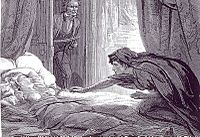
"Carmilla" by
D. H. Friston, 1872, from
The Dark Blue.
The vampire or revenant first appeared in poems such as The Vampire (1748) by Heinrich August Ossenfelder, Lenore (1773) by Gottfried August Bürger, Die Braut von Corinth (The Bride of Corinth (1797) by Johann Wolfgang von Goethe, Samuel Taylor Coleridge's unfinished Christabel and Lord Byron's The Giaour (1813). Byron was also credited with the first prose fiction piece concerned with vampires: The Vampyre (1819). However this was in reality authored by Byron's personal physician, John Polidori, who adapted an enigmatic fragmentary tale of his illustrious patient. Byron's own dominating personality, mediated by his lover Lady Caroline Lamb in her unflattering roman-a-clef, Glenarvon (a Gothic fantasia based on Byron's wild life), was used as a model for Polidori's undead protagonist Lord Ruthven. The Vampyre was highly successful and the most influential vampire work of the early 19th century.
Varney the Vampire was a landmark popular mid-Victorian era gothic horror story by James Malcolm Rymer (alternatively attributed to Thomas Preskett Prest), which first appeared from 1845 to 1847 in a series of pamphlets generally referred to as penny dreadfuls because of their inexpensive price and typically gruesome contents. The story was published in book form in 1847 and runs to 868 double-columned pages. It has a distinctly suspenseful style, using vivid imagery to describe the horrifying exploits of Varney. Another important addition to the genre was Sheridan Le Fanu's lesbian vampire story Carmilla (1871). Like Varney before her, the vampire Carmilla is portrayed in a somewhat sympathetic light as the compulsion of her condition is highlighted.
No effort to depict vampires in popular fiction was as influential or as definitive as Bram Stoker's Dracula (1897). Its portrayal of vampirism as a disease of contagious demonic possession, with its undertones of sex, blood and death, struck a chord in Victorian Europe where tuberculosis and syphilis were common. The vampiric traits described in Stoker's work merged with and dominated folkloric tradition, eventually evolving into the modern fictional vampire. Drawing on past works such as The Vampyre and "Carmilla", Stoker began to research his new book in the late 19th century, reading works such as The Land Beyond the Forest (1888) by Emily Gerard and other books about Transylvania and vampires. In London, a colleague mentioned to him the story of Vlad Ţepeş, the "real-life Dracula," and Stoker immediately incorporated this story into his book. The first chapter of the book was omitted when it was published in 1897, but it was released in 1914 as Dracula's Guest.
One of the first "scientific" vampire novels was Richard Matheson's 1954 I Am Legend which as been used as the basis for the films The Last Man on Earth in 1964, The Omega Man in 1971, and I Am Legend in 2007.
The 21st century has brought more examples of vampire fiction, such as J.R. Ward's Black Dagger Brotherhood series, and other highly popular vampire books which appeal to teenagers and young adults. Such vampiric paranormal romance novels and allied vampiric chick-lit and vampiric occult detective stories are a remarkably popular and ever-expanding contemporary publishing phenomenon.[154] L.A. Banks' The Vampire Huntress Legend Series, Laurell K. Hamilton's erotic Anita Blake: Vampire Hunter series, and Kim Harrison's The Hollows series, portray the vampire in a variety of new perspectives, some of them unrelated to the original legends.
The latter part of the 20th century saw the rise of multi-volume vampire epics. The first of these was Gothic romance writer Marilyn Ross' Barnabas Collins series (1966–71), loosely based on the contemporary American TV series Dark Shadows. It also set the trend for seeing vampires as poetic tragic heroes rather than as the more traditional embodiment of evil. This formula was followed in novelist Anne Rice's highly popular and influential Vampire Chronicles (1976–2003).[155] Vampires in the Twilight series (2005–2008) by Stephenie Meyer ignore the effects of garlic and crosses, and are not harmed by sunlight (although it does reveal their supernatural nature).[156] Richelle Mead further deviates from traditional vampires in her Vampire Academy series (2007–present), basing the novels on Romanian lore with two races of vampires, one good and one evil, as well as half-vampires.
Film and television
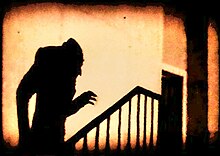
Iconic scene from F. W. Murnau's
Nosferatu , 1922
Considered one of the preeminent figures of the classic horror film, the vampire has proven to be a rich subject for the film and gaming industries. Dracula is a major character in more films than any other but Sherlock Holmes, and many early films were either based on the novel of Dracula or closely derived from it. These included the landmark 1922 German silent film Nosferatu, directed by F. W. Murnau and featuring the first film portrayal of Dracula—although names and characters were intended to mimic Dracula's, Murnau could not obtain permission to do so from Stoker's widow, and had to alter many aspects of the film. In addition to this film was Universal's Dracula (1931), starring Béla Lugosi as the Count in what was the first talking film to portray Dracula. The decade saw several more vampire films, most notably Dracula's Daughter in 1936.
The legend of the vampire was cemented in the film industry when Dracula was reincarnated for a new generation with the celebrated Hammer Horror series of films, starring Christopher Lee as the Count. The successful 1958 Dracula starring Lee was followed by seven sequels. Lee returned as Dracula in all but two of these and became well known in the role.[159] By the 1970s, vampires in films had diversified with works such as Count Yorga, Vampire (1970), an African Count in 1972's Blacula, the BBC's Count Dracula featuring French actor Louis Jourdan as Dracula and Frank Finlay as Abraham Van Helsing, and a Nosferatu-like vampire in 1979's Salem's Lot, and a remake of Nosferatu itself, titled Nosferatu the Vampyre with Klaus Kinski the same year. Several films featured female, often lesbian, vampire antagonists such as Hammer Horror's The Vampire Lovers (1970) based on Carmilla, though the plotlines still revolved around a central evil vampire character.[159]
The pilot for the Dan Curtis 1972 television series Kolchak: The Night Stalker revolved around reporter Carl Kolchak hunting a vampire on the Las Vegas strip. Later films showed more diversity in plotline, with some focusing on the vampire-hunter, such as Blade in the Marvel Comics' Blade films and the film Buffy the Vampire Slayer. Buffy, released in 1992, foreshadowed a vampiric presence on television, with adaptation to a long-running hit TV series of the same name and its spin-off Angel. Still others showed the vampire as protagonist, such as 1983's The Hunger, 1994's Interview with the Vampire: The Vampire Chronicles and its indirect sequel of sorts Queen of the Damned, and the 2007 series Moonlight. Bram Stoker's Dracula was a noteworthy 1992 film which became the then-highest grossing vampire film ever. This increase of interest in vampiric plotlines led to the vampire being depicted in films such as Underworld and Van Helsing, and the Russian Night Watch and a TV miniseries remake of 'Salem's Lot, both from 2004. The series Blood Ties premiered on Lifetime Television in 2007, featuring a character portrayed as Henry Fitzroy, illegitimate son of Henry VIII of England turned vampire, in modern-day Toronto, with a female former Toronto detective in the starring role. A 2008 series from HBO, entitled True Blood, gives a Southern take to the vampire theme. Another popular vampire-related show is CW's The Vampire Diaries. The continuing popularity of the vampire theme has been ascribed to a combination of two factors: the representation of sexuality and the perennial dread of mortality.[161] Another "vampiric" series that has recently come out is the Twilight Saga, a series of films based on the book series of the same name.
